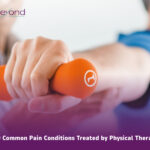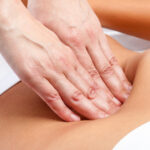Are you a weekend warrior? Do you sit too much and work too hard? If so, you may have already experienced knee pain at some point in your lifetime. Like most injuries, knee pain has the ability to heal on its own. Although there are local injuries that occur in and around your knee. Some of which may include tendonitis, arthritis, torn meniscus, ligament injuries, etc. Broader changes in the muscles, nerves and arteries can also occur. As injuries change the landscape of your knee joint. The information sent to your knee via the nervous system may also get affected. Therefore, other areas of the body that influence your knee may begin to compensate. In order to know how to heal knee pain, taking a local and broader perspective is essential.
If your acute knee injury has become more chronic, these other areas of your body start compensating for weakness, imbalance or pain. Has an old knee injury resulted in lower back or hip pain? Have you experienced pain or discomfort in the opposite hip, knee or ankle? This is fairly common. Your body is smart and is trying to stabilize. Making up for any weaknesses on your injured side. This cascade of events happens without you even realizing it. Your body does it automatically.
Integrative Healing
In this blog post on “How to Heal Your Knee Pain” is our focus. Dr. Carr Integrative Physical Therapy will provide an understanding of the main types of acute and chronic knee pain. How they manifest and come to understand how unassuming areas of our body may relate or contribute to healing your knee pain.
As mentioned earlier, like most injuries, knee pain or injury has the ability to heal on its own. How to heal knee pain requires proper hands on treatment, strength exercises, balance training, agility and coordination. Your knee is often good to go within 6 to 12 weeks depending on the severity of your injury. ACL recovery is more involved, and takes 6-9 months or more to fully heal. However, when there is increased stress and repetitive overuse possible re-injury to ligaments or meniscus can occur. These so-called easy to heal injuries can turn into longer term chronic issues and compensations.
If your acute knee injury has become more chronic. Often times, as discussed above, other areas of your body may compensate for weakness, imbalance or pain. And although it seems unrelated, hormonal changes can also influence a woman’s ability to heal. In women, ligament laxity changes throughout their monthly cycles may affect stabilization of the ACL ligament. The monthly cycle can increase inflammation throughout the body. Increasing risk of injury.
In this How to Heal Your Knee Pain blog, we will discuss anatomy, unassuming areas of the body that may be the cause or contributing factors to your nagging chronic knee pain. As well as solutions that can help reduce or eliminate your pain.
Knee Anatomy
The knee anatomy consists of 3 bones. The femur, tibia and patella bones. Four ligaments to stabilize the medial, lateral, anterior and posterior inside and outside of the knee. The medial and lateral meniscus to provide joint space, shock absorption and protect the bones from arthritis. All of these deep structures are surrounded by muscles and their tendons. There are 7 muscles that cross the knee joint.
Referral Patterns
Anatomically, there are other structures in your body that can cause knee pain. What does that mean? Although your pain may manifest in and around your knee. Whether you experience popping, clicking, sharp pain, numbness or tingling around your knee. Keep in mind these symptoms may not only involve tissues in and around your knee itself. The source of these symptoms may come from these other areas of your body.
Understanding How to Heal Your Knee Pain
Often dysfunction in your hip joint can cause upper knee pain. Several nerves from your lower lumbar spine supply the muscles and tissues in and around your knee joint. These are called dermatomes and myotomes. The L4-5 nerve feeds the thigh muscle and can cause pain to the top or inside of your knee. The L5-S1 nerve feeds the IT band and outside/lateral aspect of your knee joint. And the S1-S2 nerve feeds the muscles in your hamstring and calf muscles that can cause pain behind your knee joint.
In the osteopathic and eastern medicine world, additional unassuming structures can also refer to the knee joint. Such as the fascia surrounding your liver, kidney, uterus and intestines. These are from referral patterns that refer to you knee or other musculoskeletal areas of your body.
Understanding these other anatomical regions can play a part in your long term healing is important. If they have not been taken into consideration, seek out treatment that involve these areas. As this could be the next steps to help you with longer term recovery.
Whole Body Physical Therapy
Addressing the knee itself along with the joints above and below the knee are essential. Not only checking mobility and strength of the hip and ankle. But also evaluating the pelvis and lumbar spine as the nerve pathways from these regions of the body also travel down around the knee as discussed in the section above. This total body assessment is necessary to help longer term knee pain and injuries.
How to Heal Your Knee Pain
- Your Spine. As mentioned in the referral patterns section above. There are 3 levels of nerves in your lumbar spine that can cause or contribute to your knee pain. If there is nerve compression, disc inflammation or stenosis. Any one of these can potentially cause knee pain. Nerve glide exercises for these segments may help your knee pain.
- Balance. Often times, strengthening and stretching are the main stays for knee flexibility and function. However, the ligaments in and around your knee. As well as the ligaments in and around your ankle and hip need stability and need to work together. Balance exercises may include standing on one leg while turning your head side to side. Walking with one foot in front of the other, as if you are walking a tight rope. Or attempting squats on a balance cushion. Balance helps re-train your knee and its ligaments to know where they are in space. This is called proprioception. There are little receptors in the ligaments which communicate with your nervous system and brain. If untrained, your reaction time slows down increasing your risk of injury.
- Food sensitivities. If you have had nagging knee pain that has been unresolved. And you have tried strengthening, stretching, icing, and every other treatment that makes sense. Yet you continue to experience pain, stiffness or swelling. Have you ever thought, it may be what you are eating? If you enjoy bread, pasta and other unassuming foods containing gluten such as soy sauce. Try going completely gluten free for 4-8 weeks. It may sound cliche or a fad. However, gluten is highly inflammatory. And you don’t have to experience stomach pain or have a diagnosis of celiac disease to have a sensitivity to it. Joint pain, stiffness and swelling are very common symptoms.
- Hormone Imbalances. As mentioned in the integrative healing section. An imbalance in female hormones can have an affect on soft tissue structures in the knee joint, especially the ligaments. Addressing these imbalances through exercise, hydration and an anti-inflammatory diet can improve mobility, pain reduction and overall knee health.
Take Home Message
The knee joint is prone to acute and chronic pain and inflammation from various stress and strain placed on it. Whether you have had multiple injuries from being a weekend warrior. Have become out of shape and gained some unwanted weight from being more sedentary. Or have experienced some wear and tear from a long life of activity. Proper mild to moderate exercise along with a healthy diet and lifestyle can have a positive impact on your weight, immune system and joint health. This is often easier said than done. However, with a little discipline, time and patience. You can experience a higher quality of life with an integrative approach on how to heal your knee pain.
















